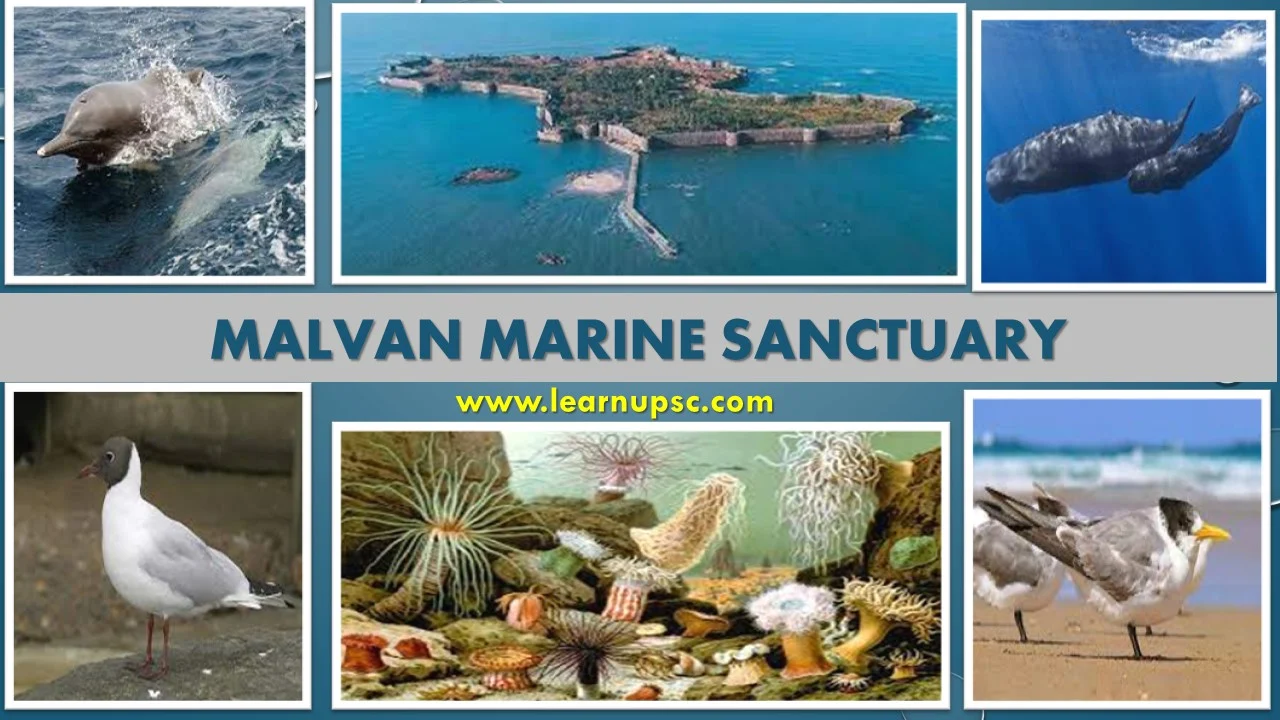Malvan Marine Sanctuary UPSC
The Malvan Marine Sanctuary is a coastal conservation area situated in the state of Maharashtra, India. The sanctuary is known for its rich marine biodiversity and diverse habitats.
Within the sanctuary's boundaries, various habitats coexist, including coral reefs, rocky and intertidal zones, and mangroves. These ecosystems support a wide array of marine life, including species like live corals, sea anemones, mollusks, polychaetes, crustaceans, bivalves, gastropods, echinoderms, fishes, sea turtles, marine mammals, and aquatic birds.
Notably, the sanctuary includes the historic Sindhudurg Fort, a monumental structure constructed by Chhatrapati Shivaji Maharaj. This fort adds cultural and historical significance to the conservation area.
Conservation efforts play a crucial role in maintaining the sanctuary's ecological integrity and protecting the diverse marine species within its borders. The sanctuary also offers opportunities for eco-tourism, allowing visitors to witness the unique marine ecosystems and the interactions between various species.
|
Table of Contents
|
Malvan Marine Sanctuary Location
The Malvan Marine Sanctuary is located in the Malvan Taluka of Sindhudurg District in the state of Maharashtra, India. It is situated along the West Coast of India and is known for its diverse marine ecosystems and rich biodiversity.
Malvan Marine Sanctuary Nearest Airport:
(i) Goa International Airport, Dabolim, Goa - Approximately 129 kilometers away from the sanctuary.
(ii) Mopa International Airport, Goa - Approximately 77 kilometers away from the sanctuary.
(iii) Sindhudurg Airport, Sindhudurg - Approximately 21 kilometers away from the sanctuary.
Malvan Marine Sanctuary Nearest Railway Station:
(i) Sindhudurg-Nagari (Oros) railway station to Malvan – Approximately 28.4 kilometers away.
(ii) Kudal railway station to Malvan - Approximately 30 kilometers away.
(iii) Kankavali railway station to Malvan – Approximately 46.4 kilometers away.
(iv) Sawantwadi Road railway station to Malvan – Approximately 52.1 kilometers away.
Malvan Marine Sanctuary History
Here's a general overview of its history:
Establishment and Recognition: The Malvan Marine Sanctuary was established and officially notified on 13th April 1987. This designation recognized the ecological significance of the marine ecosystem in the area and aimed to protect and conserve the diverse marine life and habitats found within its boundaries.
Cultural and Historical Significance: The sanctuary is also associated with the historic Sindhudurg Fort, built by Chhatrapati Shivaji Maharaj. This fort is recognized as an archaeological monument by the Archaeological Survey of India and adds a cultural and historical dimension to the sanctuary's significance.
Malvan Marine Sanctuary Area
The Malvan Marine Sanctuary covers an area of approximately 29.22 square kilometers. The sanctuary's relatively large size allows it to encompass a variety of marine habitats, including coral reefs, rocky and intertidal zones, mangroves, and more.
Malvan Marine Sanctuary Flora
The Malvan Marine Sanctuary is home to a variety of flora that thrive in its coastal and marine ecosystems. Here are some of the notable flora found within the sanctuary:
(1) Coconut Palm (Cocos nucifera):
Coconut palms are a common sight in coastal areas and are well-adapted to the sandy and saline conditions found in such environments.
(2) Corals:
Various species of corals are found in the sanctuary's coral reefs. Corals are not plants, but they are included here due to their ecological significance. Corals are colonial animals that form intricate and diverse underwater habitats, supporting a wide range of marine life.
(3) Mangroves:
Mangrove species play a crucial role in coastal ecosystems. Some of the mangrove species found in the sanctuary include Rhizophora mucronata, Avicennia officinalis, and Excoecaria species. Mangroves provide important habitats for various aquatic and bird species and help stabilize coastal areas.
(4Marine Algae (Seaweeds):
Marine algae, commonly known as seaweeds, are important components of marine ecosystems. They contribute to the overall biodiversity of the sanctuary and play roles in nutrient cycling and providing habitat.
Malvan Marine Sanctuary Fauna (Malvan Marine Sanctuary Animals)
The Malvan Marine Sanctuary is rich in marine biodiversity, hosting a wide variety of fauna species within its coastal and marine ecosystems. Here are some of the notable fauna species found in the sanctuary:
Mammals:
- Indian Ocean Humpback Dolphins
- Bottlenose Dolphin
- Spinner Dolphin
- Indo - Pacific Finless Porpoise
- Bryde’s Whale
- Blue Whale
- Sperm Whale
Birds:
- Blackheaded Gulls
- Terns
- Plovers
- Water- fowl
- Ducks
- Egrets
Others:
- Sea Anemones
- Molluscs
- Polychaetes
- Pearl Oyster
- Labeo-Calbasu
- Labeo-Rohita
Malvan Marine Sanctuary UPSC Questions
Q. Which state has Malvan Marine National Park?
A. There is no Malvan Marine National Park in India. The Malvan Marine Sanctuary is not referred to as a national park, but rather as a marine sanctuary. It is located in the Malvan Taluka of Sindhudurg District in Maharashtra, India.
Q. What is Malvan Marine Sanctuary famous for?
A. The Malvan Marine Sanctuary is famous for its diverse marine biodiversity and unique coastal and marine ecosystems. Here are some of the key aspects that make the sanctuary notable:
(i) Rich Marine Biodiversity: The sanctuary is home to a wide variety of marine species, including live corals, sea anemones, mollusks, polychaetes, crustaceans, bivalves, gastropods, echinoderms, fishes, sea turtles, marine mammals, and aquatic birds. This rich biodiversity contributes to the ecological significance of the area.
(ii) Coral Reefs: The sanctuary features coral reefs, which are complex and diverse underwater habitats. Corals provide habitat for numerous marine species and are crucial for maintaining the health of marine ecosystems.
(iii) Mangroves: The sanctuary includes mangroves, which are important coastal ecosystems. Mangroves provide habitat for various species, protect coastlines from erosion, and contribute to nutrient cycling.
(iv) Historic Sindhudurg Fort: The sanctuary's boundaries include the historic Sindhudurg Fort, built by Chhatrapati Shivaji Maharaj. This fort is recognized as an archaeological monument and adds a cultural and historical dimension to the sanctuary.
(v) Scenic Beauty: The sanctuary's coastal and marine landscapes are known for their natural beauty. The clear waters, coral reefs, and various marine species contribute to a visually appealing environment.


No comments:
Post a Comment